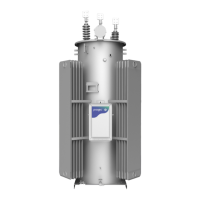GEH-7299A: Installation, Operation and Maintenance Manual
for Type VR1™ Single-Phase, Step Type Regulators
prolec.energy/prolecge
32
Trouble Cause Remedy
Regulator
bucks
when load
increases
Reversed
polarity in either
the current
transformer
or potential
transformer
Reverse the current transformer leads in the control cabinet by disconnecting
leads NN24 and NN23 (at the terminal board) and reversing the connections.
Warning: Short-circuit the current transformer so the secondary will not become
open-circuited. (The current transformer is short-circuited automatically by
removing the control-cable plug from the bottom of the position-indicator
housing.)
Line-drop
compensator
is not
functioning
in either
reactance or
resistance or
both
Shorting switch is
closed
Remove the position-indicator plug and check the shorting pin for physical defects.
If it is defective, replace it. If the shorting pin is normal, reconnect the position-
indicator plug and secure it tightly to be sure the shorting pin is disengaging the
shorting jack.
switch in OFF
position
Set switch to ON position
R65 or T3 is
defective
Disconnect the position-indicator control plug form the bottom of the position-
indicator housing; then disconnect the harnessed red nine-point connector-plug
between the control panel and the circuit component board.
Warning: Short-circuit the current transformer secondaries. If left open-circuited,
current transformers develop secondary voltages hazardous to personnel. The
current transformer is short-circuited automatically when the control-cable plug
is removed from the bottom of the position-indicator housing.
Check the primary resistance of T3 by measuring with an ohmeter across pins
Check the secondary winding of T3 by measuring with an ohmeter across
5.
Line drop
compensator
is not
functioning
in either
reactance or
resistance or
both.
Defective LDC
circuit board
Proceed as indicated in Trouble III, 2.
Trouble-shoot control with test set-up as indicated under “Calibration”. Refer to
control theory for explanation of circuit.
Defective
current
transformer
If all components in 1, 2, 3 and 4 are normal, but no compenation exists, a
defective current transformer is the probable cause.
Motor does
not operate
Motor or motor
capacitor may
be faulty.
1. Disconnect the four (4) leads from the capacitor terminals, apply 240 volts,
60 hertz to the terminals. Read the current in the line. This reading should be
approximately 0.36 amperes.
Caution: Discharge the capacitor before reconnecting the leads.
2. Reconnect the capacitor, and apply 120 volts directly to the motor. Refer to
control diagram for connections

